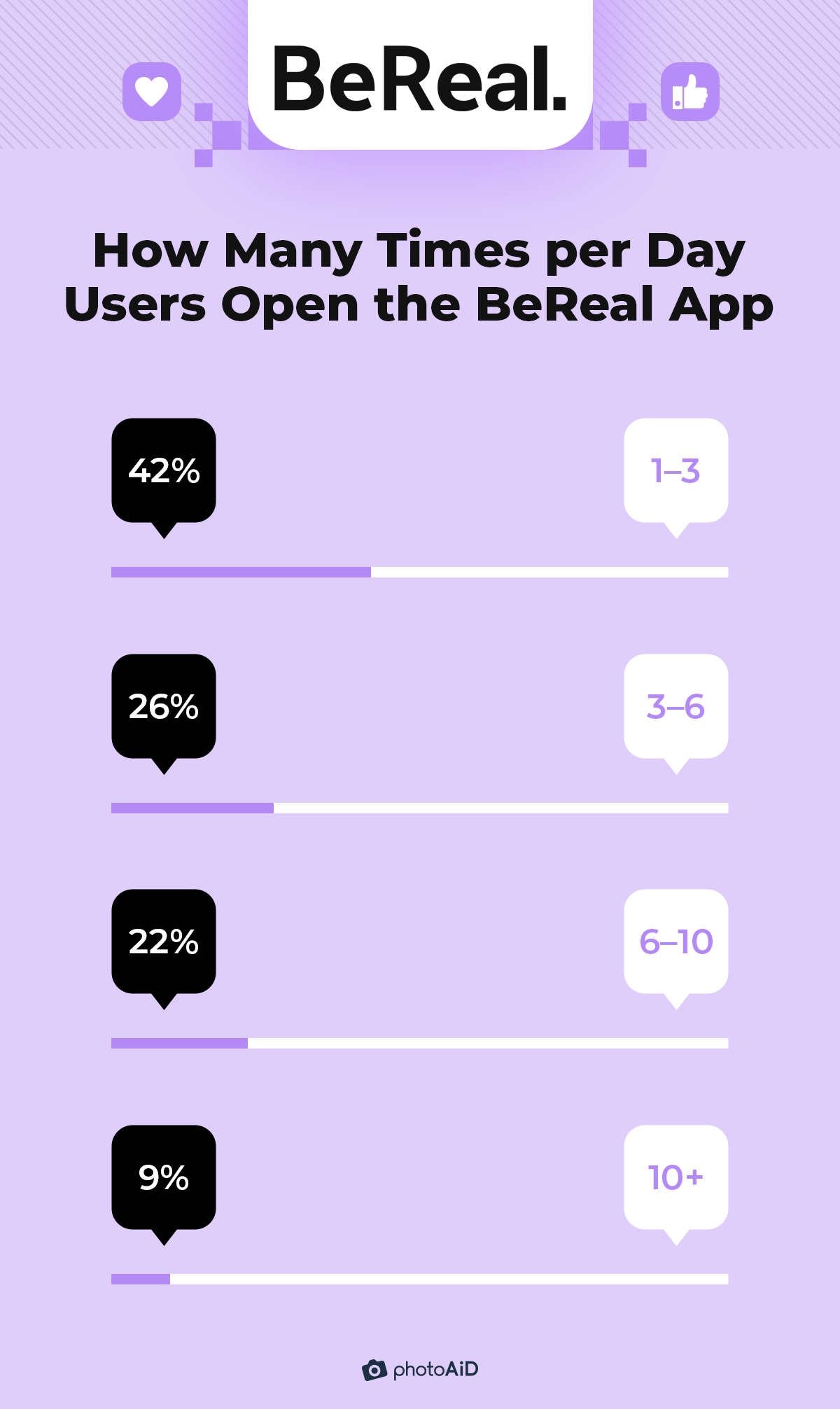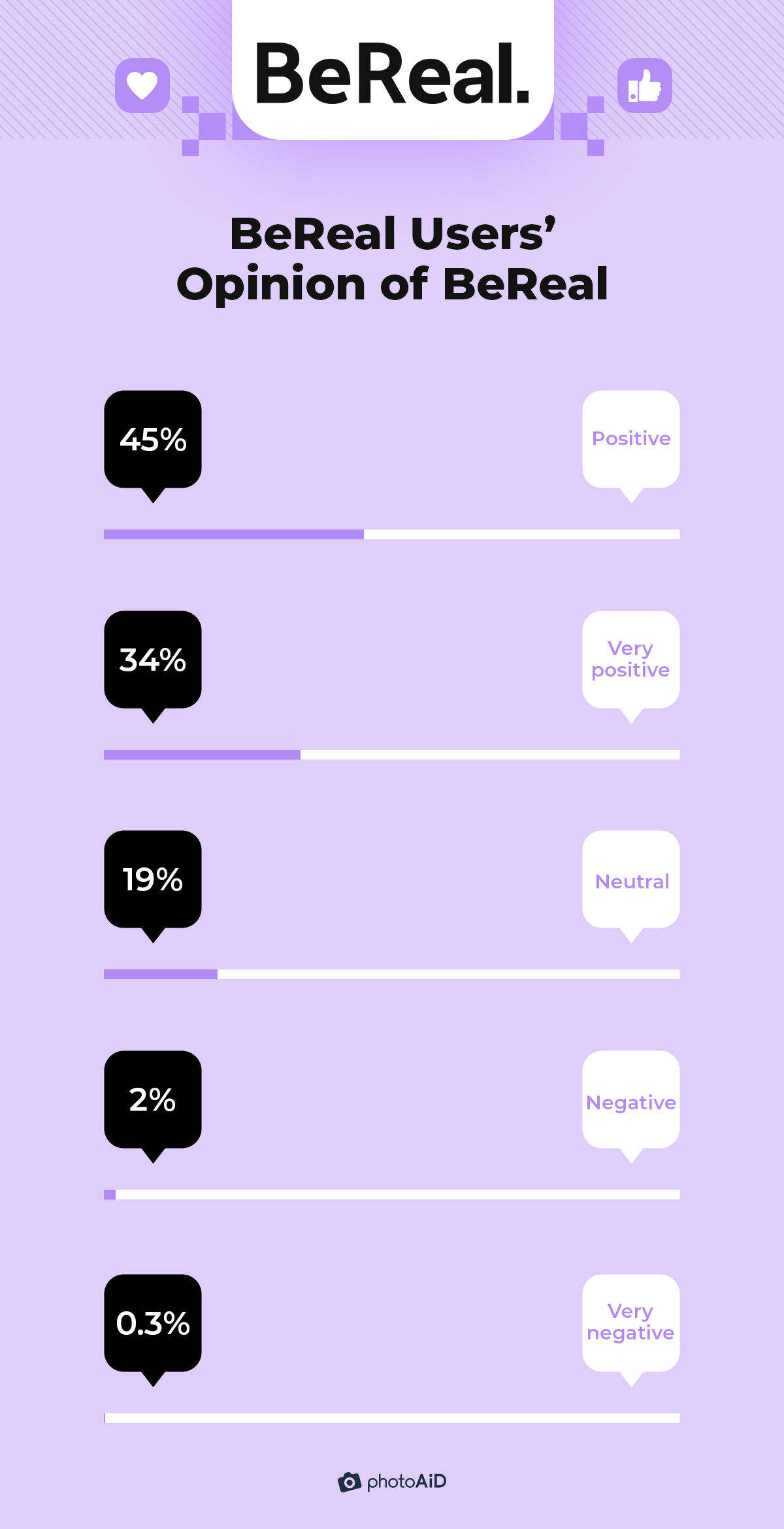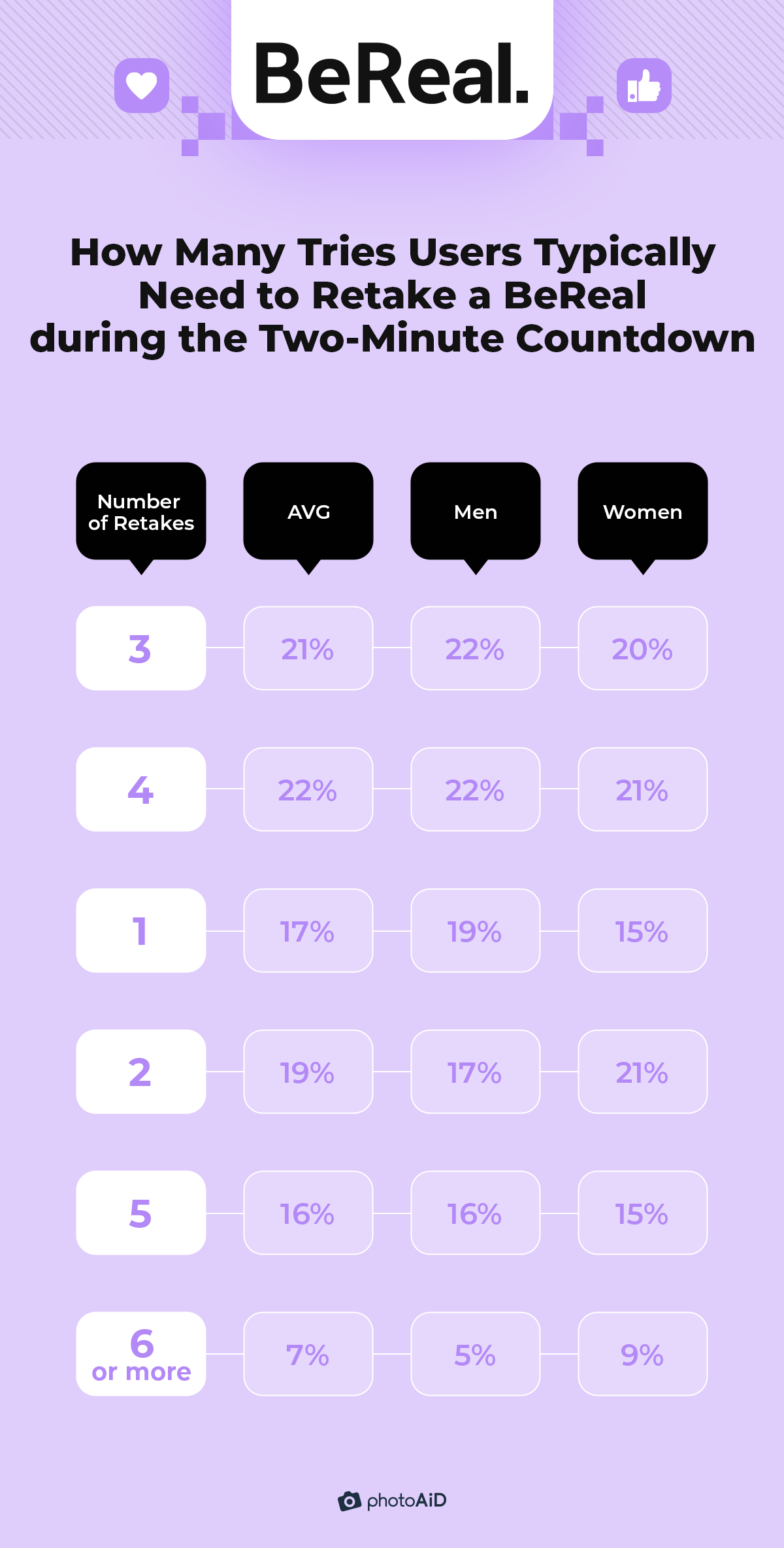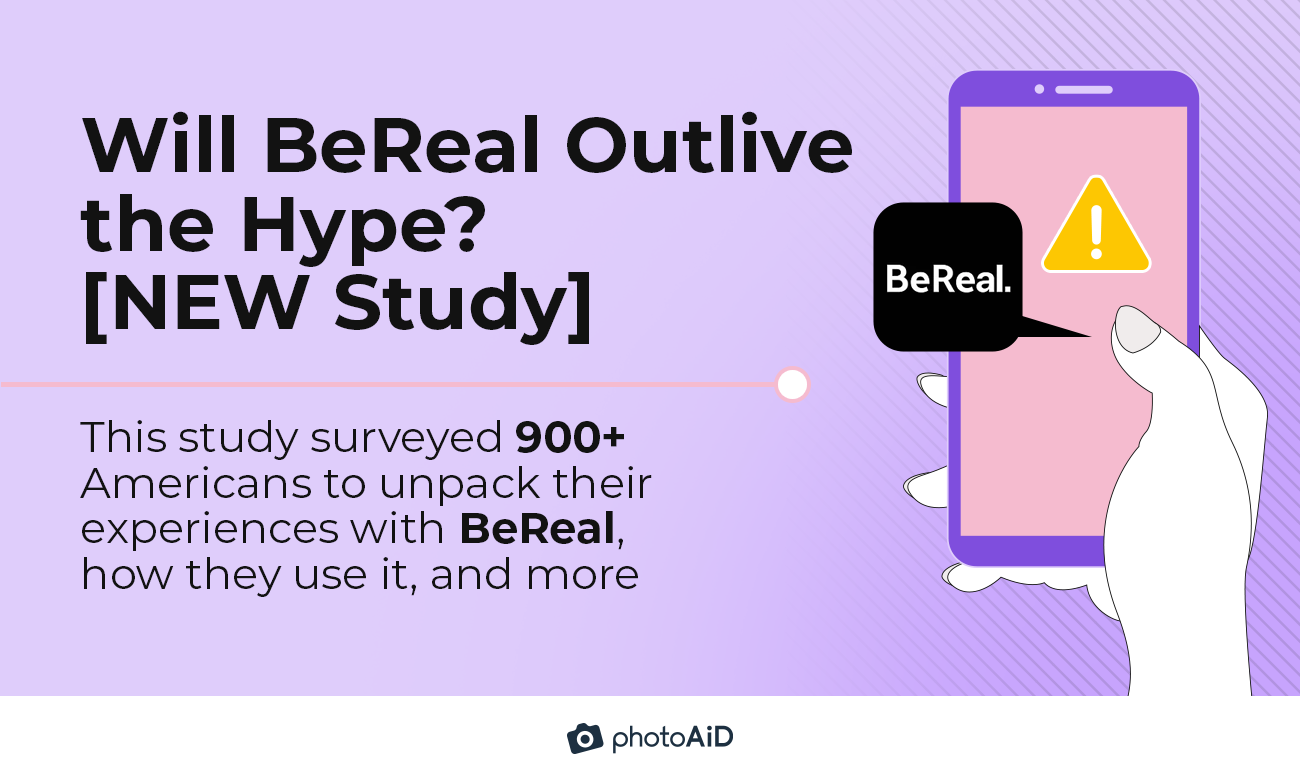The buzz around BeReal is almost palpable.
Dubbed the anti-Instagram, thanks to its efforts to counter the race for likes, followers, and popularity, this new social media app has been downloaded over 53M times globally as of October 2022.
While that number isn’t HUGE (Facebook has 5.3B+ downloads), it’s a major increase from August, when it’d been downloaded ~28M times.
So—
At PhotoAiD, we’ve decided to reach out to 900+ BeReal users in the US and unpack their experiences with the app to see if it could become the next social media titan.
Let’s dive in.
Key Takeaways
- 88% of users open the app every day, but only 77% take a BeReal on a daily basis.
- People usually spend between 20 and 40 minutes a day on BeReal.
- Most respondents find their “Time To BeReal” notifications helpful (35%), motivating (23%), and encouraging (18%).
- An average of 43% of men and women retake a BeReal 3–4 times before posting during the two-minute countdown.
- 82% of Americans admit they’ve waited for their day to be interesting to take a photo for BeReal at least once.
- 68% of survey takers experience FOMO on Bereal, and 35% say it’s more intense than on other social media.
BeReal: An In-Depth Look under the Hood
BeReal first came on the scene in December 2019.
Yet—
It stayed under the radar for ~2 years. Then in early 2022, the app surged in popularity, and it’s been on a meteoric rise since.
So, we asked Americans when they first downloaded BeReal to see how the app’s explosive growth correlates with the number of installs over time.
Below are the results:
| BeReal Downloads between 2019 and 2022 | Share of Respondents |
|---|---|
| The first half of 2021 | 17% |
| The second half of 2021 | 15% |
| The first half of 2020 | 12% |
| Q3 2022 | 11% |
| Q1 2022 | 11% |
| Q2 2022 | 10% |
| The second half of 2020 | 9% |
| Q4 2022 | 8% |
| December 2019 | 7% |
As you can see, most BeReal installs came throughout 2022 (40%). Followed by 2021 (32%), 2020 (21%), and December 2019 (7%).
Next, we asked survey takers if they use BeReal every day:
| Answer | AVG | Men | Women |
|---|---|---|---|
| Yes | 88% | 89% | 86% |
| No | 13% | 11% | 14% |
Interestingly, while 88% of respondents use the app every day, only 77% post a picture on BeReal daily, based on our further research.
Here’s also a look at how many times per day users open the BeReal app, on average:

Now, at this stage, we also wanted to ask Americans how much time they typically spend on BeReal daily.
The reason?
Unlike traditional social media like Instagram or TikTok with infinite scrolling, which 84% of Americans find addictive, BeReal is meant to be different.
Its ability to post only once a day and engage with less content should theoretically eliminate that addiction loop and prevent people from wasting hours glued to smartphones.
So here are our findings:
| Average Time Spent on BeReal (in Minutes) | Share of Respondents |
|---|---|
| 20–40 | 21.9% |
| 40–60 | 21.6% |
| 10–20 | 20.8% |
| 1–10 | 16.6% |
| 60–100 | 15% |
| 100+ | 3.9% |
The data shows that 20–40 minutes is usually how much users spend on BeReal.
Is that too much?
We’ll let you be the judge.
But just for context, the average daily time spent on Instagram is 29 minutes. On TikTok, that number shoots up to 52 minutes, whereas YouTube visitors average 19 minutes daily on the platform.
Now—
We also wanted Americans to describe their daily “Time To BeReal” notifications AND correlate it with when they installed the app. After all, it’s not hard to see how such small, recurring nudges could become tiring over time.
See the results below:
| How BeReal Users Describe Their Daily “Time to BeReal” Notifications (Correlated with When They Installed the App) | AVG | 2022 | 2021 | 2020 | 2019 |
|---|---|---|---|---|---|
| Helpful | 35% | 35% | 39% | 38% | 27% |
| Motivating | 23% | 21% | 24% | 21% | 24% |
| Encouraging | 18% | 14% | 17% | 18% | 23% |
| Intrusive | 8% | 8% | 7% | 7% | 10% |
| Annoying | 8% | 7% | 6% | 8% | 11% |
| Nagging | 5% | 8% | 3% | 4% | 3% |
The takeaway?
There doesn’t seem to be a definite downward trend in how users describe the notifications, regardless of when they installed BeReal.
Moreover, most BeReal users find their “Time To BeReal” notifications helpful (35%), motivating (23%), and encouraging (18%).
As our penultimate question, we asked respondents to rate their overall experience with using the BeReal app on their smartphones since there was a discussion in the media about how the app’s influx of users triggered glitches.
Below are the results:
| Answer | AVG | iOS | Android |
|---|---|---|---|
| Positive | 55% | 55% | 55% |
| Very positive | 25% | 21% | 29% |
| Neutral | 18% | 22% | 14% |
| Negative | 2% | 2% | 2% |
| Very negative | 0% | 0.4% | 0% |
Thus, eight in 10 users have generally had a positive or very positive experience with BeReal. Plus, Android users are more likely to rate their experience with the app as very positive (29%) than iPhone users (21%).
Lastly, we asked respondents, “In general, what’s your opinion about BeReal?” to further gauge how the public perceives the new social media:

In summary, most users (79%) have a favorable or very favorable opinion of BeReal.
But—
Will this new app become the next iteration of social media that’s outgrown fakery and performativity?
Our next section provides some insights.
Do Americans Have Trouble Keeping It Real?
BeReal urges people to share authentic (unposed and unfiltered) photos from daily life to counter the obsession for aesthetic perfection online.
So we asked survey participants to what extent they agree or disagree with the following statement, “BeReal offers a chance to show who I really am?”
Below are the results:
| Answer | Share of Respondents |
|---|---|
| Agree | 53% |
| Strongly agree | 27% |
| Neutral | 17% |
| Disagree | 3% |
| Strongly disagree | 0.7% |
The data shows that most users (80%) believe that BeReal offers a chance to be their true selves.
Another 75% feel BeReal alleviates the pressure of appearing aesthetically perfect online, based on our further findings.
But—
It’s not all sunshine and rainbows. When we asked survey participants how many tries they typically need to post a photo on BeReal during the two-minute countdown, the responses painted a somewhat different picture:

As you can see, an average of 43% of men and women retake a BeReal 3–4 times before posting. So much for being spontaneous and in the moment!
As a follow-up, we asked Americans, “Have you ever waited for your day to be interesting (e.g., you arriving at a party) to take a photo for BeReal?”
Below are the results:
| Answer | AVG | Men | Women |
|---|---|---|---|
| Yes | 82% | 80% | 84% |
| No | 18% | 20% | 16% |
While the app is built on showing users’ everyday unvarnished lives, ~8 in 10 Americans aren’t quite ready to put it all out there yet.
We also asked, “Do you experience FOMO when using BeReal?” After all, it’s easy to see how some users could feel gripped by the fear of missing out, seeing the snaps of how their friends are hanging out or partying presented as EVERYDAY slices of life.
Here are the responses:
| Answer | AVG | Men | Women |
|---|---|---|---|
| Yes | 68% | 70% | 66% |
| No | 32% | 30% | 34% |
The results are telling.
An average of 68% of respondents claim they experience FOMO on Bereal, and 35% say it’s more intense than on other social media platforms, according to our further findings.
So—
The app’s selling point may be its Achilles’ heel, at least for some people.
Stacking It All Up
There you have it!
A comprehensive look at BeReal through the prism of public opinion.
Now—
Do you think the app is just another flash in the pan, or will it outlive the hype? Or perhaps one of the big players will soon copy its unique features?
Let us know in the comments below.
Methodology
We conducted an online survey of 939 US respondents via a bespoke online polling tool in October 2022.
The respondents were 57.4% male, 42.4% female, and 0.2 identified as other. 14% of respondents were 25 or younger, 53.9% were aged 26–38, 24.6% were aged 39–54, and 7.6% were 55 or older.
This survey has a confidence level of 95% and a margin of error of 3%. Given the gender and age makeup of our sample size, the study’s findings are statistically significant for the population at large.
This study was created through multiple research steps, crowdsourcing, and surveying. Data scientists reviewed all survey participants’ responses for quality control. The survey also had an attention-check question.
Fair Use Statement
Did our findings help you learn more about BeReal? If you believe your audience will be interested in this information, feel free to share it. Just remember to mention the source and link back to this page.
Sources
- Dean B., “TikTok User Statistics (2022)”
- Gallardo A., “Facebook: 110+ Statistics, Facts, and Trends [2022]”
- McLachlan S., “23 YouTube Stats That Matter to Marketers in 2022”
- Sklencar A., “20 BeReal Stats You Need to Know (Updated November 2nd, 2022)”
- Woolf M., “100+ Instagram Stats, Facts, and Trends You Need to Know [2022]”
- Woolf M., “Scrolling Social Media for Dopamine [2022 Study]”

As a Digital PR specialist and a member of the Society of Professional Journalists (SPJ), I have 5+ years of writing experience.
Over the course of my career, my work has garnered significant attention, with features in numerous prominent publications such as The New York Times, Forbes, Inc., Business Insider, Fast Company, Entrepreneur, BBC, TechRepublic, Glassdoor, and G2.









